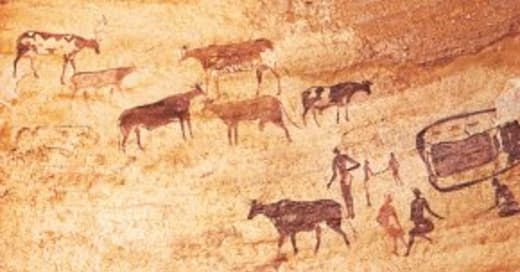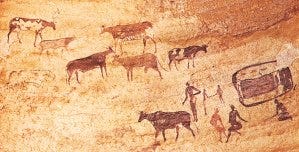People have long suspected that climate shapes attitudes and behavior. In The Spirit of the Laws (1748), French philosopher Baron de Montesquieu claimed that cold air increases blood flow to the heart. He expected this increased circulation to “produce various effects; for instance, a greater boldness, that is, more courage; a greater sense of superiority, that is, less desire of revenge; a greater opinion of security, that is, more frankness, less suspicion, policy, and cunning.”
Modern research has debunked such direct links between climate and character, but scholars continue to investigate the relationship between culture and climate. Advances in computing and the availability of paleontological climate data have allowed them to ask more nuanced questions and conduct more careful analyses.
This post discusses recent work in historical political economy that considers the effects of historic climate patterns on present-day cultural traits and behaviors. It builds on my previous post about the economic and social effects of the Little Ice Age in Europe.
Mechanisms that link climate to cultural outcomes
There are several possible channels through which climactic features, such as variation in temperature and precipitation, as well as weather shocks, may influence cultural traits. First, there is a direct physical and psychological effect of experiencing particular weather patterns. Work in behavioral economics, psychology, and medicine has established that the weather affects a broad range of emotions. We may feel sad when it rains and happy when the sun comes out. Extreme heat has been linked to aggressive behaviors and crime rates. Weather anomalies threaten our livelihoods and survival, producing psychological responses.
Second and most relevant to this post, people adapt to their environment. They adopt beliefs and behaviors that ensure survival in a given climatic conditions, learning from one another and passing the information to their offspring, or they migrate in search of more hospitable environments. The observed differences between cultural traits and behaviors may be thus, in part, the product of human adaptation to a wide range of habitats. For instance, climate influences agricultural practices, which affect the value of cooperation, optimal family and community size, gender norms, and so on. Researchers have also highlighted the effects of climate shocks and resulting resource availability on conflict, which also shapes cultural traits and behaviors.
From climate patterns to agricultural practices
One of the earliest forms of adaptation to climate is the invention of agriculture. Andrea Matranga argues that climactic seasonality, which peaked some 12,000 years ago due to the oscillations in the tilt of Earth’s rotational axis, facilitated the adoption of agriculture. Seasonality encouraged hunter-gatherers to store foods and transition from a nomadic to a sedentary lifestyle, eventually leading to the invention of agriculture. While farmers may have eaten less than hunter-gatherers, on average, storing food smoothened their consumption, reducing episodes of starvation. Using a panel of reconstructed climates for the past 22,000 years around the world, Matranga estimates that a 10°C increase in the range of annual temperature accelerated the arrival of agriculture by approximately 1,000 years.
In a related article, Quamrul Ashraf and Stelios Michalopoulos argue that agriculture developed at intermediate levels of climate volatility through the gradual accumulation of knowledge about the local environment. Extreme climate volatility eliminated the underlying resource base and prevented ecological experimentation whereas stability reduced incentives to experiment and search for alternative sources of food.
Climate also determined the form of agricultural activity, which, in turn, shaped norms and behaviors. For instance, Alberto Alesina, Paola Guiliano, and Nathan Nunn show that societies that practiced on plough agriculture developed gendered division of labor and more unequal gender norms than societies that practiced shifting cultivation. They use FAO data on geo-climatic characteristics that facilitate growing plough-positive cereals (wheat, barley, and rye) and plough-negative cereals (sorghum, foxtail millet, and pearl millet) to construct an instrument for historical plow use.
In a recent paper, Christoph Eder and Martin Halla propose that reliance on animal husbandry increased the rates of births outside marriage. This is because in husbandry the workload was distributed evenly throughout the year, which meant that most workers were permanently employed as farmhands, lived on the farms and paid in kind. The farmhands were less likely to marry, producing more illegitimate offspring who also became farmhands. This equilibrium source of cheap labor contributed to the toleration of illegitimate children and explains why today, when agriculture is no longer the dominant form of production, non-marital births are more prevalent, the incidence of shotgun weddings is lower, and the acceptance of single parenthood and cohabitation is higher in regions where husbandry rather than crop farming predominated.
How climate shaped norms and beliefs
As the proverb goes, cursing the weather is never good farming. Johannes Buggle and Ruben Durante argue that the need of subsistence farmers to cope with climatic risk generated demand for cooperation and cultivated norms of generalized trust. They support this argument using high-resolution climate data from Europe for 1500-2000 in combination with contemporary survey data on self-reported trust in 25 countries. Duc Anh Dang and Vuong Anh Dang find similar patterns in Viet Nam, where a single drought could devastate a farming community in the absence of insurance and credit markets. They calculate extreme rainfall variation and year-to-year deviation in rainfall using data that starts in 1927 and measure interpersonal trust and borrowing behavior in a 2008 survey. They show that rural households in regions with greater variation in rainfall have higher interpersonal trust and are more likely to ask village members and family members for monetary help in emergencies.
Does climate have a direct effect on cultural traits, in addition to indirect effects via agricultural practices? Jeanet Sinding Bentzen evaluates the religious coping hypothesis, whereby individuals turn to God to deal with adverse shocks. Using both cross-sectional and panel data, she demonstrates that living in an earthquake-risk zone predicts higher religiosity, and that individuals become more religious in the aftermath of an earthquake. The challenge for her analysis is disentangling the psychological “coping” mechanism from the economic effects of earthquakes. To do so, she excludes districts directly hit by earthquakes, which experience physical damage. She also compares unpredictable disasters to predictable disasters, for which the coping mechanism may be less relevant, and separately examines intrinsic religiosity (praying in private, etc.) and extrinsic religiosity (churchgoing), which can be used to obtain material resources.

Bentzen’s findings echo an earlier PNAS article by Carlos A. Botero and coauthors who link ecological stress to belief in moralizing high gods. Botero et al. argue that believing in moralizing gods increases cooperation, which is essential for survival in challenging habitats. There is also some evidence that climate extremes as well as earthquakes, wildfires and other ecological stressors increase conservatism and support for hierarchy and authoritarianism (see this review by Conway et al.). Other research indicates that climate may affect the persistence of culture itself. Paola Guiliano and Nathan Nunn argue that variable climate reduces the importance societies place on maintaining their traditions and learning from previous generations (see more detail in earlier post on cultural transmission).
Methodological challenges in climate research
There a few methodological issues to keep in mind when evaluating the evidence that climate influences norms and behaviors.
A typical study assumes that climate patterns or weather shocks are exogenous to the outcomes of interest. Exogeneity enables researchers to study climate as a causal variable and to use climate variables as instruments for other variables (which requires an additional step, defending the exclusion restriction). The exogeneity assumption may be more defensible for earlier historical periods, before major human interventions that influence local temperature and precipitation, from deforestation and the draining of swamps to paving the roads and roofs with asphalt. As Schultz and Mankin show, additional threats to exogeneity arise when human-generated weather data are used.
Even when the exogeneity assumption is reasonable, omitted variable bias remains a problem, because climactic conditions are fixed in space and affect multiple outcomes. Climate influences economic behavior, institutions, and cultural traits in complex ways, but controlling for variables that are themselves affected by climate shocks introduces post-treatment bias (see this review by Dell, Jones, and Olkens). For instance, Evert Van de Vilert suggests that affluent societies in more demanding climates tend to prefer and develop democratic institutions, whereas poorer societies in harsh climates prefer more hierarchical political organizations and autocratic institutions. The challenge with testing this hypothesis is that economic development is itself affected by climate.
One solution is estimating the short-run effects of climate in a panel framework. For instance, in addition to studying how living in earthquake-prone regions affects religiosity, Bentzen estimates the effects of earthquakes on changes in religiosity using repeated unit observations. This allows her to hold geography, political institutions, and economic development constant. Such analyses are possible only with high-frequency weather data and multiple measures of the same outcome, which are rarely available for historical periods. This estimation approach is particularly challenging for slow-moving outcomes like culture.
Finally, selection into specific climactic conditions is an issue that arises in both panel and cross-sectional analyses. Migration is among the earliest human adaptations to inhospitable environments and resource scarcity. People who remain in localities prone to extreme weather may be different from those who leave. “The stayers” might be more cooperative or risk-acceptant, which poses challenges for some of the findings discussed above.




